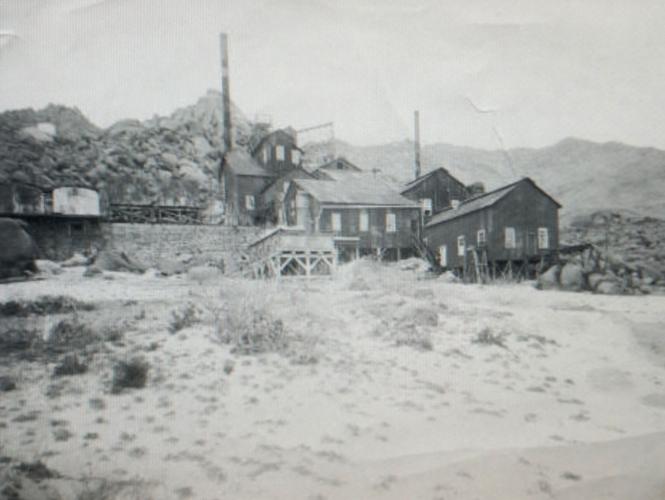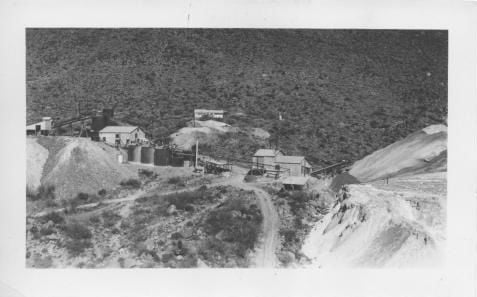Yavapai County has historically ranked number one in gold production in Arizona.
Over half of its production has derived from the Congress-Yarnell-Stanton area.
The nearby town of Stanton at the base of Rich Hill, an isolated extension of the Weaver Mountains, had a bloody history.
Named for Charles P. Stanton, a former assayer at the Vulture mill near Wickenburg, the town at one time had a population of over two hundred miners. It included a five-stamp mill, boarding house and multiple stores, including a general store run by Charles P. Stanton.
Stanton also owned an interest in the Leviathan prospect near Rich Hill.
His claim to notoriety was his indirect involvement in competing business interests, which he wanted to wrest control over their holdings.
Stanton hired Francisco Vega in 1886 to murder stage station operators John Timmerman and Barney Martin. Afterward Stanton was killed by Cristo Lucero, an associate of Vega, over an insult he directed at Lucero’s sister.
The Alvarado Mine was located amid steep slopes and dry washes in 1897 by Henry L. Scott who was employed at the nearby Congress Gold Mine. It’s at the base of Yarnell Hill in the southwest corner of the Weaver Mountains, about four miles northeast of Congress Junction. The area had sporadic development throughout the 20th century.
Also known as the old Planet Saturn Mine, it was first worked for high-grade gold ore by the Planet Saturn Mining Co. prior to the company’s bankruptcy in 1905. The development included two 800-foot inclined shafts to exploit gold and silver deposits in the ore-bearing quartz unit. It was composed of a series from one to five quartz beds, or veins, averaging three feet in thickness of iron, lead, zinc and copper sulfide.
Famous mines nearby in the Weaver or Rich Hill Mining district include the Congress Mine four miles west and the Octave Mine six miles southeast.
Aside from those two, the Alvarado was the third-largest producer in the district.
James W. Neill made an extensive survey of the mine beginning in 1907 with 500 assays taken of material throughout the mine.
Neill concluded that 176,230 tons of ore remained to be mined at the site.
The mine could produce 200 tons of ore per day. However, the set market price of gold at $20 per ounce may have been a factor in a lull in mining operations that lasted decades due to the expense of sustained mining operations at the site.
The greatest production occurred from 1938 to 1942, with 140,000 tons of gold ore mined and processed under the Liberty Hill Gold Mining Co.
After taking a loan of $90,000, it employed 40 miners and had a daily production rate of 90 tons.
Lloyd Farnum served as mine manager over the development and operation of an onsite cyanide plant. The original loan was fully paid as part of the $1.5 million valued production. However, Limitation Order No. 208 issued by the U.S. War Production Board in 1942 forced the mine to close at the 1400 level.
Inactivity over the years resulted in the mine filling with water.
Interest continued in the mine over the large tonnage of low-grade ore that required higher metal prices and less costs for profitable extraction.
A 1980 report concluded that the mine produced over 25,000 ounces of gold and 32,000 ounces of silver. It went on to say that 15 percent of the ore-bearing unit had been mined out to a depth of 1,500 feet.
Pope Mining (Scarth Petroleum) owned the property and dewatered the mine down to 500 feet below the surface, obtaining mineral samples.
Lower than expected mineral grades of .17 opt (ounces per ton) coupled with a drop in metal prices forced the mine owner’s to lease the property to Nor-Quest Arizona Inc., a Canadian mining company for 100 Krugerrands.
Surface and dump sampling were undertaken, yet the next 100 Krugerrand payment failed to surface six months later and the Scarth’s went on to sell the property.
Although interest continued in the potential of fluxing ore from the Alvarado Mine, no action has subsequently been taken nor has there been further development of the seven patented and 12 unpatented lode and placer claims on BLM land.





